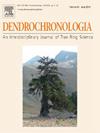Tree-ring width and blue intensity chronologies of three co-existing conifer species from the Russian Altai mountains reveal different climate signals
IF 2.7
3区 农林科学
Q1 FORESTRY
引用次数: 0
Abstract
The Altai in southern Siberia is one of the few mid-latitude mountain ranges where summer temperatures have been reconstructed over the past 2000 years. While tree-ring width (TRW) measurements have traditionally been used, the paleoclimatic potential of more advanced wood density parameters from different tree species remains largely unexplored in this region. Here, we examine the climatic response of three co-existing conifer species (Larix sibirica Ledeb., Pinus sibirica Du Tour and Picea obovata Ledeb.) from the Russian Altai at ∼1600 m a.s.l. We develop TRW, latewood blue intensity (LWBI), and delta blue intensity (DBI) chronologies, and compare them against monthly temperature means and precipitation totals over the 1951–2021 period. Our results show that all three species respond positively to summer temperatures. The LWBI and DBI chronologies exhibit stronger and more consistent summer temperature signals than TRW, with the highest correlations found in P. obovata (r = 0.7) and P. sibirica (r = 0.5). Despite species-specific differences in temperature sensitivity, our findings demonstrate the potential of LWBI and DBI for robust summer temperature reconstructions in inner Eurasia.
俄罗斯阿尔泰山三种针叶树的年轮宽度和蓝强度年代学揭示了不同的气候信号
西伯利亚南部的阿尔泰山脉是过去2000年来夏季气温得以重建的少数中纬度山脉之一。虽然传统上使用树木年轮宽度(TRW)测量,但在该地区,来自不同树种的更先进的木材密度参数的古气候潜力仍未得到很大程度的探索。本文研究了三种共存针叶林树种(落叶松)的气候响应。我们开发了TRW、晚木蓝强度(LWBI)和三角洲蓝强度(DBI)年表,并将它们与1951-2021年期间的月平均温度和降水总量进行了比较。我们的研究结果表明,这三种物种对夏季温度都有积极的反应。与TRW相比,LWBI和DBI年表表现出更强和更一致的夏季温度信号,其中P. obovata (r = 0.7)和P. sibirica (r = 0.5)的相关性最高。尽管温度敏感性存在物种特异性差异,但我们的研究结果表明,LWBI和DBI在欧亚大陆内部的夏季温度重建中具有强大的潜力。
本文章由计算机程序翻译,如有差异,请以英文原文为准。
求助全文
约1分钟内获得全文
求助全文
来源期刊

Dendrochronologia
FORESTRY-GEOGRAPHY, PHYSICAL
CiteScore
5.50
自引率
13.30%
发文量
82
审稿时长
22.8 weeks
期刊介绍:
Dendrochronologia is a peer-reviewed international scholarly journal that presents high-quality research related to growth rings of woody plants, i.e., trees and shrubs, and the application of tree-ring studies.
The areas covered by the journal include, but are not limited to:
Archaeology
Botany
Climatology
Ecology
Forestry
Geology
Hydrology
Original research articles, reviews, communications, technical notes and personal notes are considered for publication.
 求助内容:
求助内容: 应助结果提醒方式:
应助结果提醒方式:


